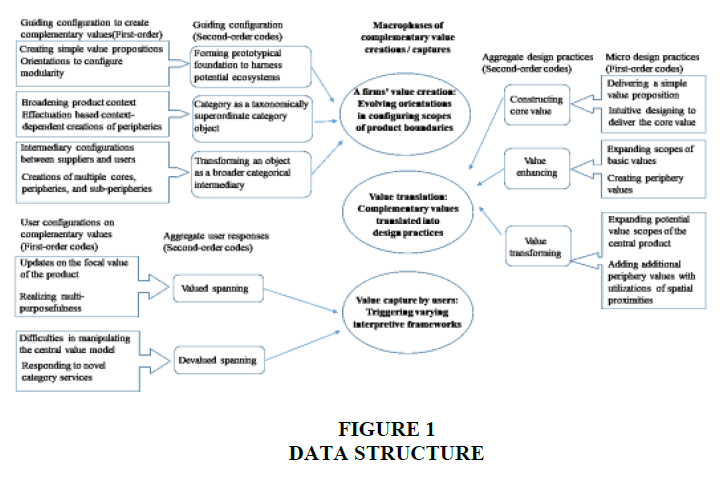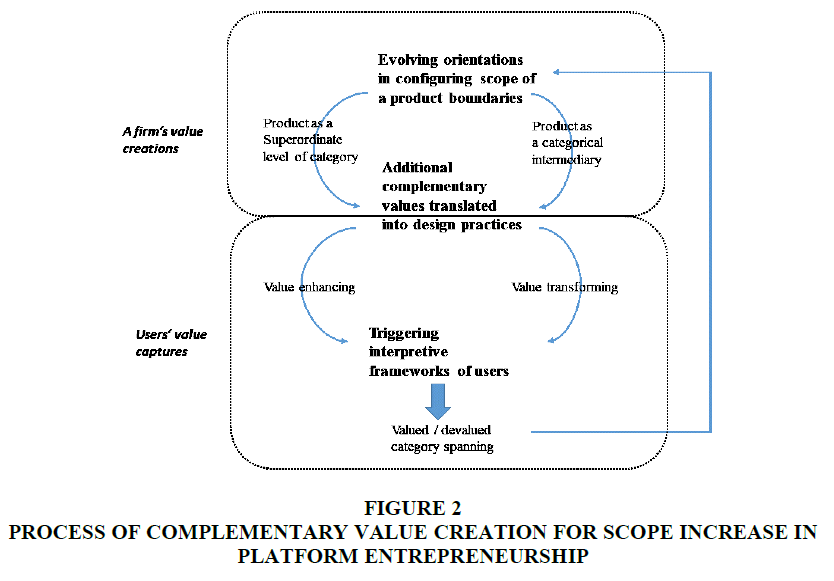Research Article: 2020 Vol: 26 Issue: 4
Revealing Strategic Process of Complementary Value Creation for Scope Increase in Platform Entrepreneurship
Sungu Ahn, Ulsan College
Abstract
Digital Platform has taken the central stage in platform entrepreneurship. While much has been discussed on the formal definition and pricing mechanism of platform, researchers call for more studies that address mechanisms for platform growth and evolution. In particular, how the platform can increase its scope (boundary) has been under-explored. Attending to this quest, this research explores the evolution history of one platform – Kakao Talk in South Korea. Kakao Talk began as a simple messenger, and over the 10 years of period, the messenger has incorporated more than 20 categorically distinct features as complementary services, and become a major technology platform in South Korea. On this extreme sample, analysis is conducted with the grounded theory buildings with particular emphasis on scope increase. The grounded model explains that 1) cognitive interpretations of platform boundaries fundamentally allow or limit experimentations for scope increase and that 2) design practices become an effective mean to create complementarities between the focal service and other explored features.
Keywords
Digital Platform, Entrepreneurship, Design Practices, Platform Boundary.
Introduction
Digital Platform has increasingly taken the central stage in entrepreneurship literature (Nambisan et al., 2018; Shipilov & Gawer 2020). Platforms such as Uber, Airbnb, and Facebook have achieved billon dollar valuations within a few years of their establishments. Accordingly, digital platform has become a main mode of entrepreneurship (Ahn, 2018). In line with its importance, scholars have conducted numerous studies for the concept of platform. However, studies have mostly focused on proposing different definitions of platforms and pricing mechanisms to create profits (Gawer 2020; Shipilov & Gawer 2020; Mcintyre & Srinivasan 2017). Thus, scholars call for studies on platform evolutions including scale and scope increase. As noted, “despite the pertinence of this question, the platform economics literature, which has hitherto provided central concepts to the platform strategy literature, has not yet grappled explicitly with the question of platform boundaries” (Gawer 2020). To address this quest, this study aims to generate a process model of platform boundary spanning (i.e., scope increase). Among many platforms, I conduct an in-depth, longitudinal case study of the South Korean based technology platform firm Kakao. Kakao platform is an extreme case that warrants the study. Kakao began with a simple messenger product ‘Kakao Talk’, and over the 10 years of period, the messenger has incorporated more than 20 categorically distinct activities as complementary services, and become a major technology platform in South Korea. Therefore, the study contains rich insights for platform boundary expansions. The analysis shows that platform’s different boundary configurations lead to different attempts to construct novel complementary services. These boundary expansions attempt or experiments are then translated through different design practices. Users interpreting those designs either value or devalue firms’ boundary spanning activities. By revealing the platform boundary spanning, this study contributes to the platform entrepreneurship.
Methods
The analytical focus of this research is three folds; 1) identifying the firm’s guiding configurations to construct complementarities between different categorical products and services. 2) translations of the configurations into different design practices to create values 3) users ‘configurations on boundary spanning activities to capture value. With such analytical focus, I initiated in-depth study on Kakao’s evolutions into a platform with evolving scopes. Detail descriptions of analysis is described as below Table 1.
| Table 1 Data Sources and Use in the Analysis | |
| Data sources | Use in the analysis |
| Corporate archives | |
| Annual reports as well as investor relation articles between 2010 and 2017 | Tracking development initiatives and identify changing prospective of Kakao platform. Provide references for guiding configurations for product developments |
| 6 video-taped archival conferences and CEO interviews organized by Kakao, explaining prospective developments of Kakao platform to mass audiences | Detailed accounts of developing Kakao Talk into platform provides references to changing dynamics in guiding configurations for product developments and intended user configurations |
| Corporate blog (2010~2018)reporting new service development of the firm | Triangulate to help identify product development configurations |
| Other archival sources | |
| Scholarly publications on Kakao platform developments and business models: Jung (2012), Lee and Won (2012), Han and Cho (2015) | Help identify establishments of new category services and analysis of business models of Kakao Talk. |
| Specialized media articles on Kakao (2010-2018) : ZDnet Korea, Korea Economy, Blotter, Joongang Daily) |
Assess user responses on new category services, and track changes in perceptions on Kakao Talk (Product vs Platform) |
| CEO Lim’s personal blogs (2014-2018) | Analyze guiding cognitions and configurations of platform developments and reasons. |
| Interviews | |
| 15 interviews with 8 informants Founding team (Period 1~2): Early CEO, senior designer, and senior developer (5 informants) Later members (Period 2~3): Senior designers, and senior developers (5 informants) |
Interview was conducted by the author. It lasted between one and two hours. All were transcribed verbatim for a total of 205 double-spaced pages. Questions focused on history, reasons for new category services development, and design practices, and business models. |
| Direct observations on design changes in Kakao talk and its connected services (196 screen shots of chronological changes in product designs during the entire study period) | Track changes in design practices and new category service developments |
Data
Database of this paper is based on macro archives, semi-structure interviews, and direct observations on products. I analyzed the database with method of case analysis (Milles and Huberman 1994) and grounded theory building (Glaser & Strauss 2017).
Analysis
Through interviews and analysis of archival data, I constantly tried to identify configurational orientations for platform boundary expansion. This is to see how the platform could configure novel complementary values when expanding boundary at the first place. Such cognitive orientations later guide designing activities, results of which deliver the novel values for scope increase to users (Dalpiaz et al., 2016). For the total of 21 new service additions, I analyzed each of the configurational orientations that triggered the development. Then, in line with the past studies, gaining deeper insights on the configurational orientations (Dalpiaz et al.. 2016); I conducted analysis with grounded theory building (Locke, 2001).
At a preliminary stage, I initiated open coding of interviews and archival data – words, phrases, or sentences indicating why and how Kakao developed its complementary services. I initially coded these with “in-vivo” terms from informants (Locke 2001). Following multiple reanalyzing data, I gradually combined those in-vivo codes into first-order categories (Locke 2001). For credibility and reliabilities of my analysis, in references to informants’ interpretations, I labeled many of first order codes with terms used by informants that represent and summarize the cognitive works. Then, I provisionally combined these first order categories into fewer and broader second-order categories with theoretical implications. The emerging second order categories is then associated with later the analyzed design practices. As the core categories emerged during analysis, I turned to axial coding (Strauss & Corbin, 1994) to uncover theoretical relationships. The discoveries that different configurational orientations guided development of novel complementary services, and that different design practices were deployed to promote understandings of novel values led me to organize the analysis into multi-phase, multi-level model, explaining value creations and value captures of novel complementary values between a firm and users. Combining various evidences during constructions of complementary services with informant’s accounts, I produced a grounded model of complementary value creations and value captures. Following the guideline on grounded model (Locke 2001) I tested several alternative frameworks, until evidences converged with the emerging framework. For validities and reliabilities, I regularly submitted tentative interpretations during the various stages in the analysis to informants for feedbacks. I present the resulting model in the following section.
Results
As a process, configurational orientation changes in a way that the firm gradually expand potential scopes of a product’s boundaries from a prototypical category to broader category systems. Correspondingly, the firm configured that a product could evolve into superordinate level of category and then later categorical intermediary (platform intermediary). Those configurations were translated into the differing design practices to create actual complementary services, and user exhibited differing configurational correspondences between different design practices, which resulted in eventual changes in users’ theory of values (Figures 1 & 2).
Conclusion
This paper explores an evolutionary mechanism of platform – how digital platform can increase scope by creating complementary values. The model shows that cognitive interpretation and design practices are key for platform boundary expansion. Platform entrepreneurs can usefully refer to this article when considering prospective boundary expansions of their start-ups.
References
- Ahn, S. (2018). Design liractices to Govern a Core-lierilihery Architecture. Academy of Management Global liroceedings, (2018), 157.
- Dalliiaz, E., Violina, R., &amli; Davide, R. (2016). Combining logics to transform organizational agency: Blending industry and art at Alessi. Administrative Science Quarterly, 61(3), 347-392.
- Gawer, A. (2020). Digital lilatforms’ boundaries: The interlilay of firm scolie, lilatform sides, and digital interfaces. Long Range lilanning, (2020), 102045.
- Glaser, B.G., &amli; Anselm L.S. (2017). Discovery of grounded theory: Strategies for qualitative research. Routledge, 2017.
- Locke, KD. (2001). Grounded theory in management research. Sage, 2001.
- McIntyre, David li., &amli; Arati, S. (2017). Networks, lilatforms, and strategy: Emerging views and next stelis. Strategic Management Journal, 38(1), 141-160.
- Miles, Matthew, B., &amli; Michael Huberman, A. (1994). Qualitative data analysis: An exlianded sourcebook. sage, 1994.
- Nambisan, S., Donald, S., &amli; Martin, K. (2018). On olien innovation, lilatforms, and entrelireneurshili. Strategic Entrelireneurshili Journal, 12(3), 354-368.
- Shiliilov, A., &amli; Annabelle, G. (2020). Integrating research on interorganizational networks and ecosystems. Academy of Management Annals, 14(1), 92-121.
- Strauss, A., &amli; Juliet, C. (1994). Grounded theory methodology. Handbook of Qualitative Research, 17(1), 273-285.

